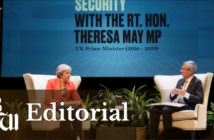A painting of a girl reaching out to grasp a red, heart-shaped balloon and a racist comment written on a bathroom stall. Both of these are considered “graffiti,” but these two ideas express very different sentiments.
Small snippets of graffiti are everywhere on Lehigh’s campus, whether in a bathroom stall or a library cubicle. You can find comical stick figures, Greek symbols, declarations of love, confessions and, unfortunately, many offensive remarks. While all of these are against Lehigh’s Student Conduct & Community Expectations — which prohibit the defacement of school property — as students, we are most concerned by the use of our shared spaces to perpetuate hateful statements.
These vicious statements seem to spring up when students have the chance to express themselves anonymously, like the racist vandalism that was found in a University Center bathroom on Aug. 27, the hate crime committed outside the Umoja House and the insulting comments on the free speech wall last year.
Most of these insensitive messages are written in commonly viewed areas. Some of them are permanent, like etchings on a desk, while others can be erased, but they last in people’s memories long after the physical evidence of the graffiti has been removed.
Anonymity gives a message power and lets the impact of hatred fester without closure. The lack of context or identity amplifies the statement and gives it the power of the unknown. When we have no one with whom to attribute a message, it becomes easy to assume that the statement made is a popular campus belief, a notion that is not necessarily true. Or, more importantly, there is no way to address the comments directly and start a discussion about campus views.
Meaningful conversations don’t happen on the back of bathroom doors. They occur when people are open, honest and unafraid to say what they think. They occur when people can respond to statements, not when a message becomes a dead end above a roll of toilet paper.
The diversity of opinion and experience is one of the most rewarding aspects of college. We are all unaware of certain aspects of each other’s lives, but our level of understanding will never change if students don’t take the risk to voice their opinions and listen to feedback from their peers.
Lehigh has dealt with anonymous hate speech before, and in the case of the Umoja vandalism, over 1,000 students and faculty immediately responded by uniting for a rally. That rally sparked a discussion, but one that was mainly among those already involved in such conversations. Excluded from the discussion was the person responsible for the crime. Anonymity served as protection from the resulting reaction.
Regardless of whether opinions are spoken or not, the thoughts are there. Let’s draw those thoughts out from our minds and turn them into conversations. The only way we can identify how to respond to statements is if the people who write those statements identify themselves. Instead of hiding behind the comfort of obscurity, stand behind your beliefs, and don’t write things that you are not willing to attach to your name to.
Not everything people have to say is positive, but if we discourage people from voicing their opinions, we risk the loss of conversation as a whole. Ultimately, that conversation may be the thing that leads to progress, to change and to a deeper understanding of one another.
People might reveal thoughts that are as lovely as the painting of the girl with a heart balloon or as hateful as racist graffiti. The door to discussion is wide open, and we can handle whatever emerges.





Comment policy
Comments posted to The Brown and White website are reviewed by a moderator before being approved. Incendiary speech or harassing language, including comments targeted at individuals, may be deemed unacceptable and not published. Spam and other soliciting will also be declined.
The Brown and White also reserves the right to not publish entirely anonymous comments.